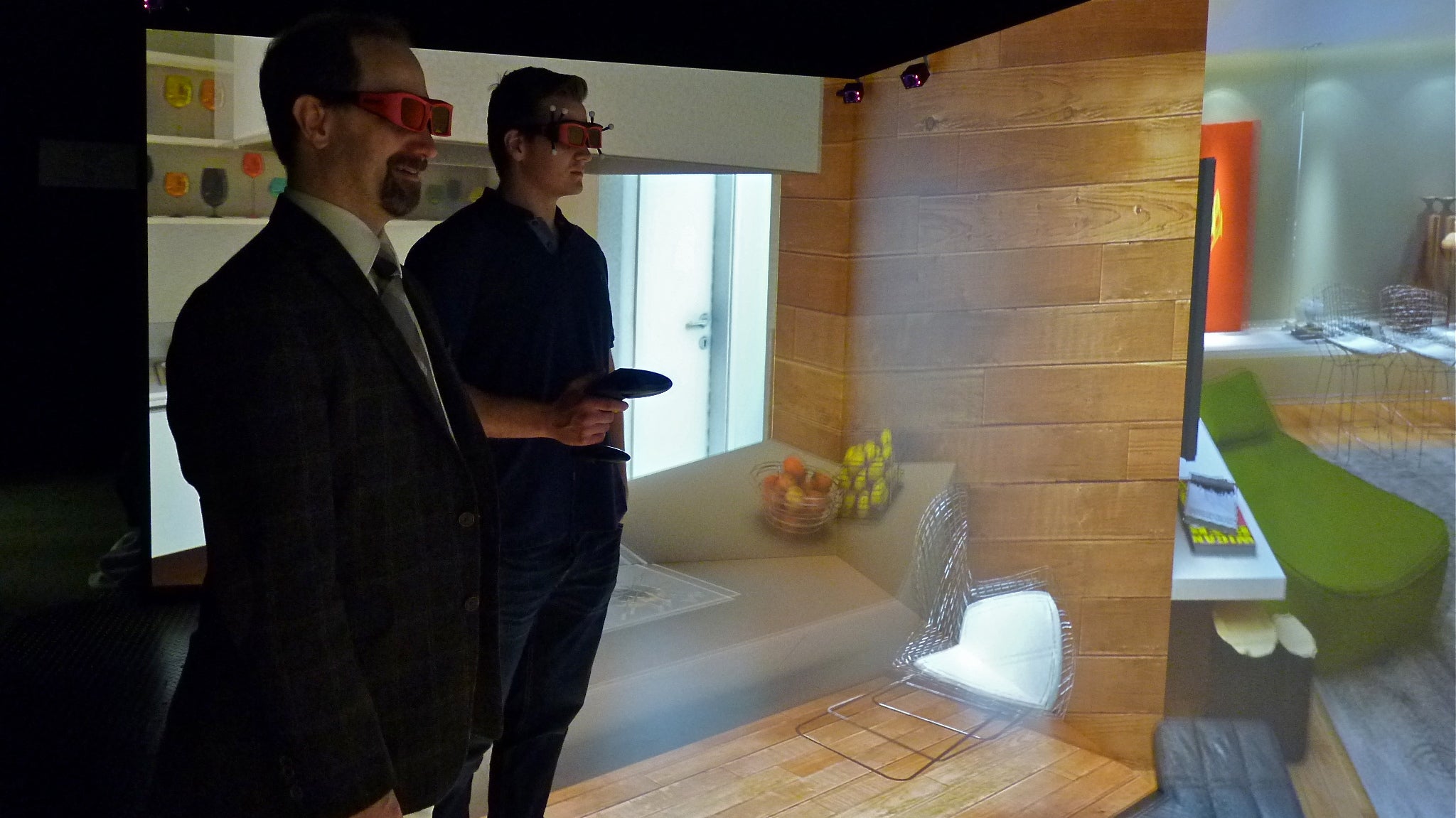Villanova University unveils interactive CAVE classroom
Listen
Villanova freshman Charles Walberg (right) explores a virtual room with computer science professor Frank Klassner. They are inside of a 'CAVE immersive learning space
Some people look good in 3-D glasses. Frank Klassner is one of the them.
The Villanova University computer science professor happily shows off his high-tech specks, which are part of a new interactive classroom on campus called the CAVE.
Cave-like, with low lighting and relatively small dimensions (18ft across, 10ft deep and 7 ½ feet high), the enclosure is made entirely of screens. Projectors shine hi-resolution continuous images on all surfaces.
“It’s not like what you would get in IMAX or a traditional 3-D movie because the projectors are surrounding you, they are not just in front of you,” says Klassner. “So as you turn your head, infrared cameras around this enclosure, they are tracking your head motion, and adjusting the display accordingly.”
The effect is a stunningly realistic display that users can control.
Klassner pulls up pictures of Mars taken the day before by NASA’s Curiosity Rover. Using a joystick, he manipulates the shots, zooming up, down, left, right, and panning up to the horizon.
“You can see that the sky of Mars is more of a butterscotch color than a blue color or a pinkish red color, and all of this is visible once you put together the big picture from all those photos in the mosaic,” says Klassner.
The experience of touring the surface of Mars is similar to playing around in Google Earth, except instead of zooming from one address to the next, the movement is seamless.
Flying through virtual worlds, however, does have its potential drawbacks.
“There is actually a documented medical condition people have found in CAVES and other immersive experiences. There’s a term ‘cyber sickness’ that’s used to describe the dizzy, occasionally nauseating experience if you move too quickly through these virtual worlds.”
The CAVE as a classroom
Villanova’s CAVE, which stands for Cave Automatic Virtual Environment, comes courtesy of a $1.67 million National Science Foundation grant, which covers the cost of the unit, along with a $15,000 hi-resolution camera that can be used to create original content.
It is the first CAVE on a college campus in the region, though companies across the country have been using the technology for a while.
Designers will take a product in the development stage and render it for the screen. Architects and urban planners use CAVES to turn sketches into experiences.
Klassner says that allows them to better explore a space, and look at things like lighting and movement.
“Check it out in 3-D first, but immersive 3-D. Not just on the screen, but immerse yourself. Say, ‘this will work if you turn this into a physical reality.'”
Klassner pulls up a virtual model of a newly renovated lounge and study area on campus, and invites a student to put on the glasses.
“Wow,” says freshman Charles Walberg. “I’m really blown away by a) how similar it looks to the room I’ve actually been in before, and then b) I guess, just how real it looks, how lifelike everything is.”
Using the joystick, Walberg tools around the space. Using buttons on the joystick, he can pick up chairs and tables to rearrange the seating configurations of the virtual lounge.
The computer science major sees how this technology could benefit his classwork.
“You can read things, and you can try to understand them that way, by just reading a textbook,” says Walberg. “But I think you really learn best when you visually understand something, and I think this does a great job of that, and will be a great learning tool.”
Time and cost limit the creation of these virtual worlds, meaning it could be a while before there’s a CAVE exercise on every syllabus.
But Professor Klassner says he’s been talking up the technology with professors across the school.
“We are going to be working with all the different academic departments at Villanova, from philosophy to physics,” says Klasser. “There’s a lot of excitement.”
Biology students could take an interactive tour of the double helix. How about a marshland habitat for environmental sciences majors? Dim the lights, put on some funny glasses, and the classroom becomes the real world. Sort of.
WHYY is your source for fact-based, in-depth journalism and information. As a nonprofit organization, we rely on financial support from readers like you. Please give today.



